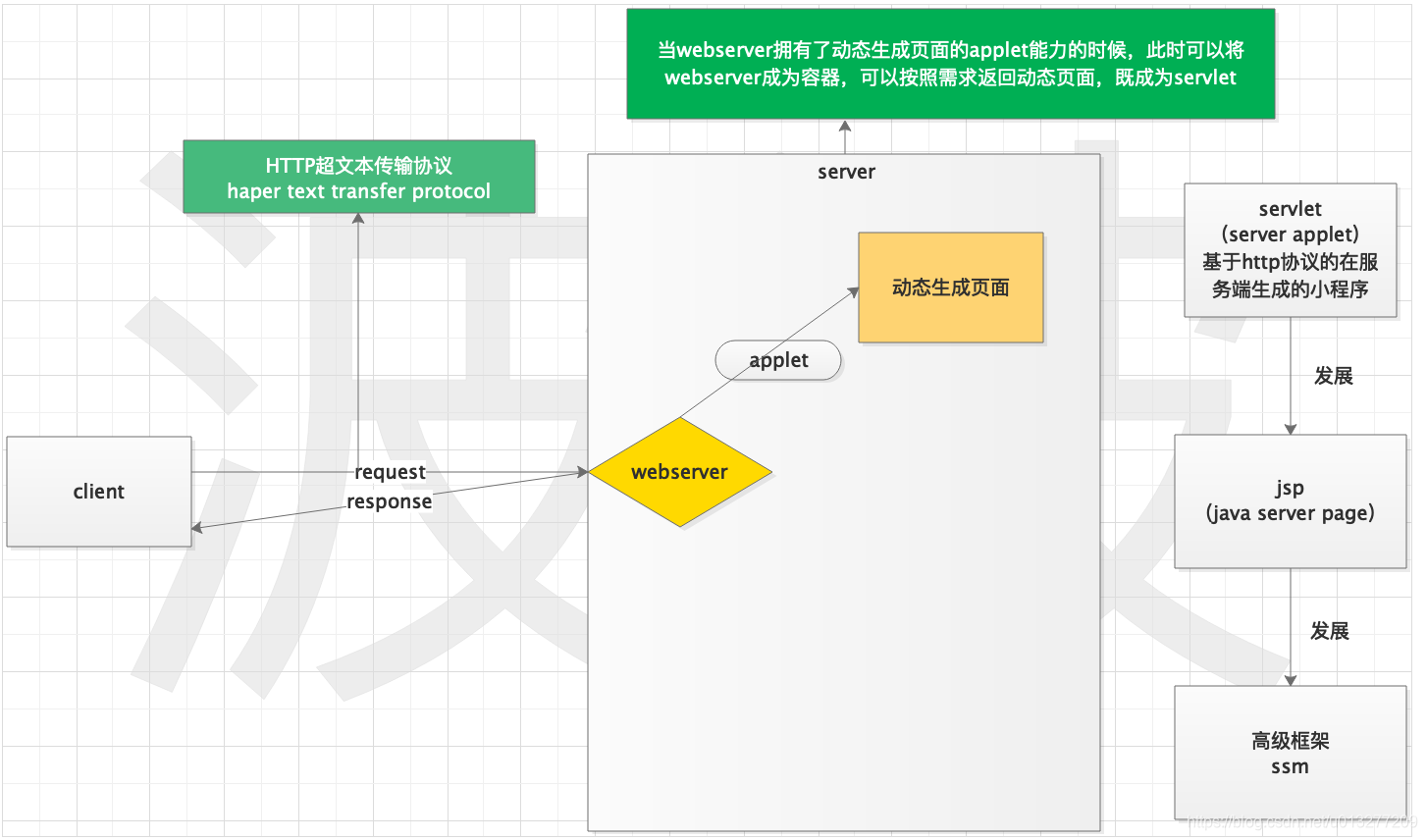一、什么是Servlet
是一种Web服务器端编程技术。
是实现了特殊接口的Java类。
由支持Servlet的Web服务器调用和启动运行。
一个Servlet负责对应的一个或一组URL访问请求,并返回相应的响应内容。

二、Servlet和http请求
1、http请求格式

2、http请求方式

get请求和post请求区别:
- get请求参数是会显示到地址栏的,post不显示。
- get请求不安全,post请求安全。
- get请求参数长度限制,post不限制。
3、http状态响应吗


三、Servlet服务
1、servlet和Tomcat请求关系:

2、简单撸一个Tomcat
package com.bobo;
import java.io.InputStream;
public class MyRequest {
//客户端请求类型
private String requestType;
//客户端请求URL
private String requestUrl;
public MyRequest(InputStream inputStream) throws Exception {
byte[] bytes = new byte[1024];
int len = inputStream.read(bytes);
String text = new String(bytes, 0, len);
String firstLine = text.split("\n")[0];
String[] firstTextArray = firstLine.split(" ");
this.requestType = firstTextArray[0];
this.requestUrl = firstTextArray[1];
}
public String getRequestType() {
return requestType;
}
public void setRequestType(String requestType) {
this.requestType = requestType;
}
public String getRequestUrl() {
return requestUrl;
}
public void setRequestUrl(String requestUrl) {
this.requestUrl = requestUrl;
}
}
package com.bobo;
import java.io.OutputStream;
public class MyResponse {
private OutputStream outputStream;
public MyResponse(OutputStream outputStream) {
this.outputStream = outputStream;
}
public void write(String str) throws Exception{
StringBuilder stringBuilder=new StringBuilder();
stringBuilder.append("HTTP/1.0 200 ok\n")
.append("Context-type:text/html\n")
.append("\r\n")
.append("<html>")
.append("<body>")
.append("<h1>"+str+"</h1>")
.append("</body>")
.append("</html>");
outputStream.write(stringBuilder.toString().getBytes());
outputStream.flush();
outputStream.close();
}
}
package com.bobo;
public abstract class MyHttpServlet {
private static final String REQUEST_GET="GET";
private static final String REQUEST_POST="POST";
public abstract void doGet(MyRequest request,MyResponse response) throws Exception;
public abstract void doPost(MyRequest request,MyResponse response) throws Exception;
public void service(MyRequest request,MyResponse response) throws Exception{
if (REQUEST_GET.equals(request.getRequestType())){
doGet(request,response);
}else {
doPost(request,response);
}
}
}
package com.bobo;
public class MyServlet extends MyHttpServlet {
@Override
public void doGet(MyRequest request, MyResponse response) throws Exception {
response.write("MyTomcat Get");
}
@Override
public void doPost(MyRequest request, MyResponse response) throws Exception {
response.write("MyTomcat Post");
}
}
package com.bobo;
import java.util.HashMap;
public class MyMapping {
public static HashMap<String,String> mapping=new HashMap<>();
static {
mapping.put("/myTomcat","com.bobo.MyServlet");
}
public static HashMap<String,String> getMapping(){
return mapping;
}
}
package com.bobo;
import java.io.InputStream;
import java.io.OutputStream;
import java.net.ServerSocket;
import java.net.Socket;
public class MyService {
public static void startService(int port) throws Exception{
//服务器端套接字
ServerSocket serverSocket=new ServerSocket(port);
//客户端套接字
Socket socket=null;
while (true){
socket=serverSocket.accept();
//输入输出流
InputStream inputStream=socket.getInputStream();
OutputStream outputStream=socket.getOutputStream();
//初始化请求响应类
MyRequest myRequest=new MyRequest(inputStream);
MyResponse myResponse=new MyResponse(outputStream);
//找到合适的applet
String classString = MyMapping.getMapping().get(myRequest.getRequestUrl());
System.out.println(classString);
if (classString!=null){
Class<MyHttpServlet> clazz=(Class<MyHttpServlet>) Class.forName(classString);
MyHttpServlet myHttpServlet=clazz.newInstance();
myHttpServlet.service(myRequest,myResponse);
}
}
}
public static void main(String[] args) {
try {
startService(10087);
} catch (Exception e) {
e.printStackTrace();
}
}
}

四、Servlet访问流程
url:http://localhost:8080/firstweb/first
组成:
服务器地址:端口/虚拟项目名/servlet的别名
uri:虚拟项目名/servlet别名
过程:浏览器发送请求到服务器,服务器根据请求URL地址中的URI信息在webapps目录下找到对应的项目文件夹,然后再web.xml中检索对应的servlet,找到后调用并执行servlet。

servlet从第一次请求时创建,到关闭服务器时销毁,中间多次请求只会存在一个servlet在内存中。当在web.xml中配置了1,在开启tomcat时就会创建servlet实例。
- Service方法:不管是get还是post请求方式,如果service方法存在,则优先执行service方法。
- doGet方法:在没有service的情况下,如果是get请求,调用doGet方法。
- doPost方法:在没有service的情况下,如果是post请求,调用diPost方法。
